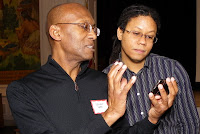Separated at birth, sort of

Can you spot the difference between these two digital cameras? The black camera is a new Kodak M583, a 14-megapixel compact with a Schneider lens, 8X optical zoom. The red camera is a GE Power Series E1680W, with 16 megapixels and an 8X optical zoom. To me, they appear to have come off the same assembly line, someplace in Asia. Their prices are nearly identical, too. At the moment, Kmart is offering the GE camera at $20 under the Kodak. On the other hand, 16 MP on a 1/2.3 sensor will probably result in less than satisfactory images. GE is one of those drugstore brands that hardly any camera review website takes seriously. Kodak, on the other hand, said earlier this year that they would re-strategize their camera business to sell only profitable cameras. I'm thinking this meant sourcing some cameras from GE's General Imaging business, just as Hewlett Packard appears to have done.

